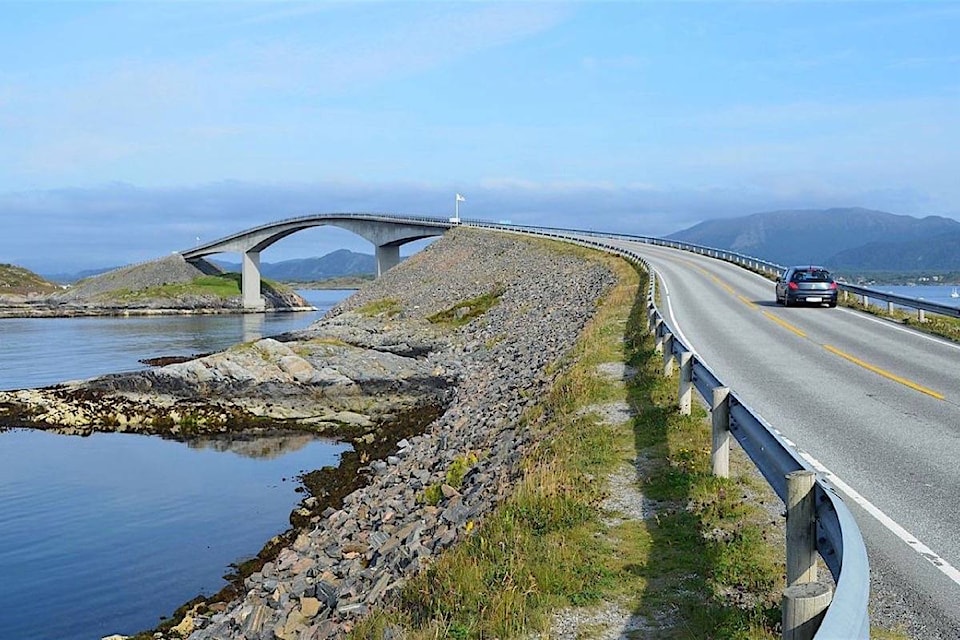Special to Black Press, by James Anderson, a B.C. public servant for 30 years and director of aquaculture and commercial fisheries for the Ministry of Agriculture, Fish and Food from 1981 to 1998. He lives in Saanich.
I recently returned from Norway, and four recent news items relate to what I observed. Three were local; the protest arising from a fish farm escape in Washington state, the decline of wild salmon stocks due to the “North Pacific blob,” and news of a new ferry vessel for North Coast. The other was an international story concerning prevalence of sea lice.
My 1,400-km coastal ferry trip from the Russian border south to Bergen was via a passenger-and-car ferry service to every community, whether 500 or 50,000 residents. Most of those communities are serviced by new airports, highways, railways and dozen of tunnels, bridges and 24-hour ferry connections.
The North Atlantic Road is miracle of highway engineering. The extent of public investment to provide access is a remarkable contrast with our almost uninhabited coast, except for Bella Bella, Bella Coola, a declining Prince Rupert and our minimalist mid-coast ferry service.
Obviously much of this is benefits from offshore oil royalties and Norway’s enormous “sovereign fund,” but the long-term vision of public officials to invest in services to offset migration to Oslo is remarkable. Trondheim, near the Arctic Circle, has a large and world-renowned university.
Today Norway conquers world economies, not by Viking raids but through diversifying their economy by adapting technology built on their maritime traditions, whether shipping, fisheries, offshore oil or aquaculture. At the same time they provide strong support for 21st-century measures including wind energy and environmental protection laws. They have done a good balancing act of marine resource development while achieving the highest standard of living in the world.
Pertinent to the news items, there has been no commercial harvest of North Atlantic salmon for several decades; those stocks are reserved for the “pay-to-fish” recreational sector common to Norway, Ireland, Scotland and Iceland. Norway back in the 1970s made a dramatic commitment to use modern science, and instead of chasing salmon they would raise them in ocean pens.
Today more than 1,500 salmon farms generate export value of more than $16 billion. Subsequently Scotland, Ireland, Chile and even New Brunswick and B.C. joined this shift from capture fisheries, adapting the fundamentals of terrestrial food production to marine environments. They provide 14 million salmon meals daily. So much for critics who won’t eat that junk!
The UN warns us of serious overfishing by capture fishery fleets, and numerous fish stocks are in danger. If the pending increase in world population to nine billion is to be fed, much of the protein must come from aquaculture. Worldwide aquaculture of all species in both marine and freshwater has increased from 35 to 60 per cent.
In B.C., wild salmon annual harvests declined in wholesale value from $250 million to less than $50 million. Our 110 salmon farms now produce $600 million, mainly for export. Norwegian companies brought their technology and made investments in B.C. to provide a future for our marine sector. To chase them away is sheer folly.
Critics suggest there is direct link between wild stock decline and emergence of fish farms, a claim which cannot be substantiated. A recent commentary in a Victoria newspaper described the negative effects of “North Pacific blob” and warmer temperatures that has significantly reduced ocean survival of salmon stocks, not just for B.C. but also for the U.S., Japan and Russia.
Understand that it took four millennia for farmers to learn how to grow crops and husband animals and they still have issues with disease and pests. Fish farmers have only been doing so for four decades so they have steep learning curve.
While mistakes have been made and escapes will occur much has been learned in past, mortality and waste has been reduced and feed conversion rates have been improved. The answer is not to ban fish farms but use knowledge to improve husbandry. We don’t eliminate schools because children have whooping cough.
Compare feed conversion rates of 1.15 for farmed salmon to pigs and cattle; and even 1.79 for chickens. Protein retention is also higher, as is edible yield. Those concerned about saving our planet should get protein from farmed salmon instead of eating most land animals.
Salmon farming has saved the economy of most North Atlantic communities. Based what has been learned from four decades of trial and error, within 10 years an ongoing scientific breakthrough will revolutionize seafood production with commercial scale farming of cod and halibut.
As a look at my home province, I see a government that ignores the North Coast, an urban populace that opposes resource development and critics who raise spurious and unfounded shibboleths regarding farmed salmon. If we continue with these policies and attitudes, the world economy will pass us by and our coastal communities will see further declines. We can and should learn from others.


